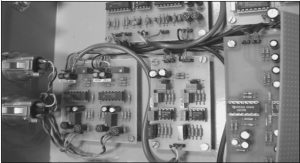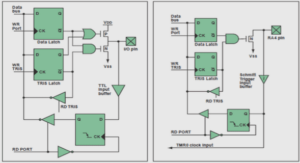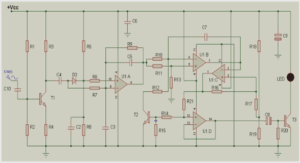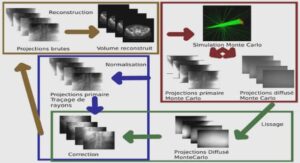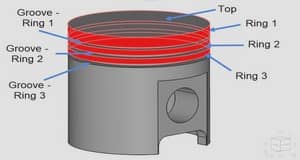Commande adaptative et gestion de l’énergie d’un véhicule électrique
History of State-of-Charge indication
For almost as long as rechargeable batteries have existed, systems capable of indicating the amount of charge available inside a battery have been around. In 1938 Heyer introduced a single-meter device on which the value of a storage battery capacity is indicated [4]. The battery capacity is indicated on the basis of the measured battery voltage and a measured voltage drop across a sense resistor. When the battery is fully charged the device indicates 100% of the capacity (see Figure.I.1). Figure. I.1. Battery capacity indicator developed by Heyer (1938) [4]. In 1963 Curtis Instruments pioneered gauges for monitoring the SOC, the ‘fuel’ level, of vehicle traction batteries. One of the methods used by Curtis involves predicting a battery’s remaining capacity by measuring the amount of time elapsed since the loaded voltage dropped below a Chapter I State-of-the-Art of battery State-of-Charge 4 certain value. [5]. the Curtis fuel gauge was found to be the most sophisticated and accurate [6]. Curtis SoC gauges were even used on the Moon (see Figure. I. 2) [7]. Figure. I.2. Astronauts exploring the Moon in Lunar Roving Vehicles in 1971–1972 relied on early Curtis gauges [7]. In one of the Curtis patents filed by Finger et al. in 1975 the current flowing from the battery is sent to an integrator module, which registers the current depletion [8]. During charging, the current is integrated in the integrator module providing a continuous display of the SOC and information needed to regulate the charge rate. An account of the attempts made to develop an SoC indicator for a nickel– cadmium battery was given by Lerner in 1970 [9]. He concluded that the only reliable way of estimating the SOC is to use a current-sharing method. In this method, the current output of a battery having a known SOC is compared with that of a battery having an unknown SOC. The SOC of the unknown battery can be deduced from the outcome of this comparison. In 1974 York et al. introduced an SOC indicator in which the value of the measured battery voltage is indicated with respect to two voltage levels stored in the system [10]. In 1974 Brandwein et al. developed a device for monitoring nickel–cadmium batteries [11]. In addition to voltage measurements, the current that flows into and out of the battery and the battery temperature are measured and used in order to provide SOC indication. In 1975 Christianson et al. developed a method in which a battery’s SoC is indicated on the basis of the open-circuit voltage (OCV) calculation [12]. The OCV is directly proportional to the battery SoC and can be calculated using the following equation: 𝐎𝐂𝐕 = 𝐕𝐛𝐚𝐭 + I.R (I.1) where Vbat is the battery terminal voltage, I the actual battery current – regarded as a positive value during discharge and a negative value during charge – and R is the internal resistance. Note that OCV = Vbat when I = 0, but after current interruption this takes a while due to several relaxation processes occurring inside a battery. The first impedance measurements of batteries appear to have been made by Willihnganz in 1941 [13]. They involved excitation of the electrochemical cell by an ac voltage of small amplitude of about 5 mV and evaluation of the resistive and reactive components or other related parameters such as the modulus of impedance and phase angle. In 1984 Peled developed a method for determining the SOC of lithium-ion batteries [14]. The presented method is based on predetermined voltage and temperature measurements that are used as input parameters for look-up tables. After a current step and a short resting period, a battery’s OCV and temperature are measured. The measured value is compared with a corresponding predetermined value stored in a look-up table. The outcome of this comparison is used to indicate the SOC. In 1981 Finger of Curtis Instruments patented a method according to which the SoC of LeadAcid (LA) batteries is determined during a quiescent interval with no current flowing through the battery [8]. The battery terminal voltage is measured after a current step and the combination of these two measurements (battery voltage and time) is used for battery OCV recovery characteristics determination. This predictable time function of voltage recovery is substantially independent of the actual voltage level of the terminal voltage. The methods presented in [15, 16] use Coulomb counting, i.e. battery current measurement and integration, as a basis. The method developed by Aylor (1992) holds for LA batteries [15]. The described technique is a combination of the previously described OCV method and coulometric measurements (Coulomb counting). The methods presented in [17, 18] also use adaptive methods for determining a battery’s SOC. In 1997 Gerard et al. developed a method in which a battery’s ‘state variables’ are replaced with neural weights with the aim of providing portable equipment users with an accurate estimation of the remaining working time, e.g. how much time is left until the battery voltage reaches the end of- discharge voltage defined in a portable device [17]. Two artificial neural networks are used to model the system’s implementation, more precisely, to adapt the prediction of the current discharge curve to the general behaviour of the employed battery pack. Chapter I State-of-the-Art of battery State-of-Charge 6 In 2000 Bergveld et al. developed a method for estimating the SOC of a rechargeable lithiumion battery [4, 19]. The basis of the algorithm is current measurement during the charge or discharge state and voltage measurement during the equilibrium state (state in which no current is flowing into or out of the battery and all the conditions inside the battery are fully stabilized). In the charge and discharge states the determination of the SOC relies on calculating the charge withdrawn from or supplied to the battery by means of current integration and subtracting this charge from or adding it to the previously calculated SOC. So, in these states Coulomb counting is applied and the battery is viewed as a simple linear capacitor. Table I.1. summarizes the most important points of the history of SOC development outlined above.
Battery Management Systems
The design of a battery-powered device requires many battery-management features, including charge control, battery-capacity monitoring, remaining rum-time information, charge-cycle counting, etc. For it to be able to offer high precision, each part of the system must be near to perfection. The basic task of a BMS can be defined as follows [20]: The basic task of a Battery Management System (BMS) is to ensure that optimum use is made of the energy inside the battery powering the portable product and that the risk of damage to the battery is prevented. This is achieved by monitoring and controlling the battery’s charging and discharging process. The DC/DC converter is used to efficiently condition the unregulated battery voltage (3-4.2 V in Li-ion chemistry) for compatibility with stringent load requirements. The basic task of the load is to convert the electrical energy supplied by a battery into an energy form that will fulfill the load’s function, such as mechanical energy, light, sounds, heat, EM radiation, etc. The battery status can be indicated in one light-emitting diode (LED) or several such diodes connected in series or on a liquid-crystal display (LCD) that indicates the SOC and the battery’s condition (e.g. the State-of-Health (SOH)) [20]. The processor is used to run the battery-management software, including the SOC algorithm. Communication between the BMS and other devices is another important task of the BMS. Depending on the application, various systems can be used for data exchange, such as an interintegrated-circuit bus interface (I2C) or some other form of serial interface. The battery state is used as an input parameter for the portable device’s electrical management and it is an important parameter for the user. The battery state can be used to estimate the battery’s expected lifetime. It can be simply described by two parameters: SOC and SOH. Both parameters depend on each other and influence the battery performance [4]. A general block diagram of a BMS is shown in Figure.I.3.
A General State-of-Charge System
In science, the quality unit want to communicate battery limit is Coulomb (named when the French scientist C. A. Coulomb, 1736–1806), that portrays the time a battery will produce a given current. The Coulomb is that the unit of electrical charge like one quantity unit (As). In observe, however, cell or battery capability is a lot of usually expressed in amperehours (Ah) or milliampere-hours (mAh). Of nice importance for users is to understand a battery’s SOC. In [21] SOC is defined as the percentage of the full capacity of a battery that is still available for further discharge. In [13] it is the ratio of a cell’s available capacity and its maximum attainable capacity. For a correct understanding of what the term ‘SOC’ extremely implies a transparent definition is needed; SOC is the percentage of maximum possible charge that is present inside a rechargeable battery. The SOC measuring methodology and also the machine model supported the right SOC definition should be straightforward, convenient, sensible and reliable. Figure. I.4. suggests an instance of a sensible SOC system. The battery may also encompass a plurality of battery cells related in sequence and/or parallel, every of the battery cells having at least two terminals. The SOC device may additionally include an analogue-todigital converter (ADC) for converting a voltage drop between at least two feel resistor connection pins as a measure of the modern-day (I) into a digital sign and also for changing the measured analogue values of the battery voltage (V) and temperature (T) into digital signals. A microprocessor/microcontroller (in which the SOC algorithm is stored) determines a battery system’s SOC on the groundwork of the measured signals. Two sorts of reminiscence are needed. Basic battery data, such as the amount of self-discharge as a function of T and the discharging efficiency as a feature of I and T, are read from the read-only reminiscence (ROM). When the SOC algorithm is primarily based on EMF measurements, the EMF–SOC relationship can be saved in ROM collectively with different battery-specific data. The random get right of entry to reminiscence (RAM) is used to save the history of use, such as the quantity of charge/discharge cycles, which can be used to replace the most battery capacity. Each part of this system (software algorithm or hardware device) will have an effect on the last accuracy of the SOC indication (e.g. inaccuracy in the V, T and I measurements will result in inaccuracy in the closing SOC). Also essential is the calibration of the SOC, because if the SOC algorithm is based on, say, present day size and integration, the error triggered via the cutting-edge measurement inaccuracy will accumulate over time.
Chapter I: State-of-the-Art of battery state-of-charge |
